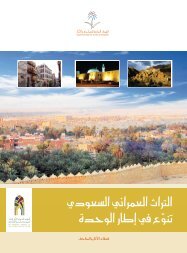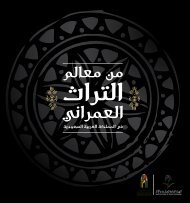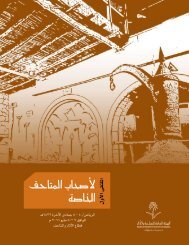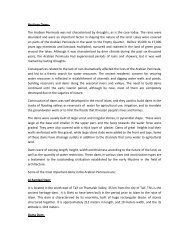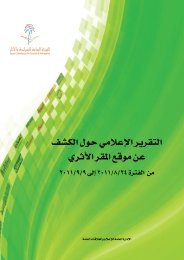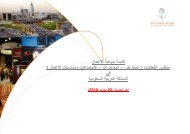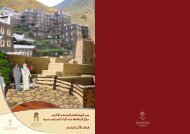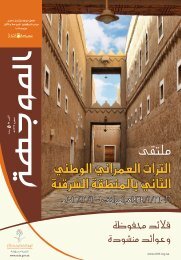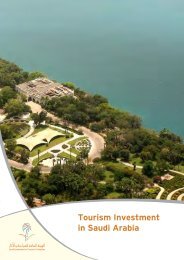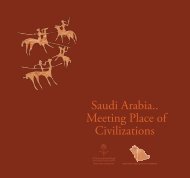Roads of Arabia
Roads of Arabia
Roads of Arabia
You also want an ePaper? Increase the reach of your titles
YUMPU automatically turns print PDFs into web optimized ePapers that Google loves.
18bis Arabie US p318-363.qxd 23/06/10 22:12 Page 340<br />
ROADS OF ARABIA<br />
Qaryat al-Faw<br />
163. Fragment <strong>of</strong> a mural painting with zodiacal motif<br />
1st–3rd century AD<br />
Black, red and yellow paint on white plaster<br />
50 x 29 cm<br />
Qaryat al-Faw<br />
Department <strong>of</strong> Archaeology Museum, King Saud University, Riyadh, 238 F 9<br />
On the right:<br />
]yn..lṭ w<br />
]d….lḥy<br />
The text, perhaps incomplete, does not provide anything we can understand.<br />
No certain reading is possible.<br />
(transcription C. R.)<br />
This enigmatic painting features an axis topped by a semicircle, from<br />
which rise clusters; around it various figures gravitate: a spotted<br />
feline, a lion, a scorpion, a centaur, a hydra; on the right, we make<br />
out the horns <strong>of</strong> a ram. These animals represent constellations<br />
arrayed around the welkin. Mesopotamians, Egyptians, Greeks and<br />
Romans were already familiar with the zodiac since Antiquity and it<br />
is probably contact with the Romans that led the South <strong>Arabia</strong>ns to<br />
adopt this repertory <strong>of</strong> zodiacal motifs. However, we do not know if<br />
this is the foundation horoscope <strong>of</strong> a building or the enthronement<br />
<strong>of</strong> a high-ranking personality or if these motifs had an entirely different<br />
meaning. This zodiacal representation differs from the few<br />
rare known exemplars in the <strong>Arabia</strong>n Peninsula, as at Zafar and<br />
Khirbat al-Tannur. 1 M. C.<br />
164. Fragment <strong>of</strong> a wall painting depicting a tower house<br />
3rd century BC–3rd century AD<br />
Black, red and yellow paint on white plaster<br />
59 x 64 cm<br />
Qaryat al-Faw<br />
Department <strong>of</strong> Archaeology Museum, King Saud University, Riyadh, 29 F 22<br />
On the right, from top to bottom:<br />
Tym<br />
Mnt<br />
Read probably Tym|mnt, “Taymmana – t”, a man’s name.<br />
Manāt is an <strong>Arabia</strong>n goddess, found in many regions <strong>of</strong> West <strong>Arabia</strong><br />
(transcription C. R.)<br />
The tower house is built on a stone foundation; on the ground floor<br />
two doors are open, one <strong>of</strong> them framing a nude figure. The storeys<br />
are built with beams forming regular frames, filled with raw bricks<br />
or earth and painted with red and black geometric motifs. At the<br />
windows <strong>of</strong> the two storeys busts <strong>of</strong> identical figures appear. The<br />
building is crowned by a crenellated décor, bearing an inscription; it<br />
is surrounded by four bounding ibexes. One <strong>of</strong> the roles <strong>of</strong> these<br />
tower houses may have been defensive; in fact the very narrow openings<br />
eventually allowed to use a bow and the terrace could serve as a<br />
lookout post. This tradition <strong>of</strong> tower houses has lasted up to today<br />
in the south <strong>of</strong> <strong>Arabia</strong>.<br />
M. C.<br />
1. Laffitte 2003, pp. 77–87, pl. 9, 10 and 11.<br />
340<br />
341



